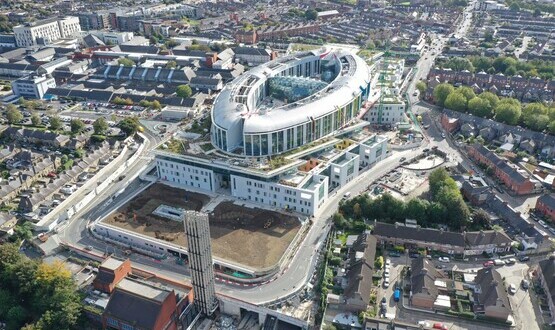How can we make interoperability happen?
- 25 April 2019

It’s a question which has plagued the NHS for many a year: how can we make interoperability happen? For Peter Anderson, the answer is through a mixture of top-down focus and regional action.
As a participant in bodies like the Professional Record Standards Body (PRSB) and INTEROPen, I’m trying to play my part in making interoperability a reality in the NHS. Matt Hancock’s energetic drive for nationally specified open standards – and the secretary of state’s promise that vendors who don’t play ball won’t work with the NHS – is definitely taking us in the right direction, and I say more power to him.
But even if we had all the necessary standards today, it could take years to build on them. New software components must be written, and existing systems upgraded.
That’s why I think that, as well as top-down focus, we need renewed regional effort to get record sharing moving. That means CCIOs and CIOs in NHS trusts accepting and working with current standards and today’s systems. Applying commonsense, proven – yet often neglected – IT project delivery capability and being open minded about what is added to integration toolkits will help give clinical users the information they need.
No secret recipe
There is no secret recipe to the interoperability successes I’ve seen over decades of working in NHS IT. Such projects aren’t over-ambitious and instead recognise that this is a journey. The data sources with the most clinical value are identified, there is a check to see if those sources are available, and then they are prioritised for integration. In these success stories, there is a plan for the long term but also a focus on delivering benefits quickly to keep clinical users motivated.
So making a go of interoperability at a local or regional level means being very clear about early objectives and ensuring full clinician engagement. Build project teams and make sure you second clinicians to them, forming a core project team that will stay the course.
The lure of the big bang approach traps so many. For example, some teams try to make source-system data perfect before allowing it to be shared. Better to accept the existing data quality – but add a data cleansing and enhancement strand to the roadmap.
Take your time
There’s no need to make every system talk to every single other one right away either. The Bristol, North Somerset and South Gloucestershire Connecting Care project started by giving social care out-of-hours access to primary care records, then progressed to an HTML view of community care data. Choosing that approach rather than full interoperability let most of the clinical benefits arrive very quickly.
There are now 180,000 views of patient records every month, and clinicians can also share discharge letters and clinical correspondence with a wide range of health and social care organisations.
Of course, the foundations must be right for the future of an interoperability project too. The infrastructure must be flexible and scalable enough to cope with more users and extra connected systems. And it has to keep working when the source systems do finally talk to each other as standard.
For the same reasons, creating the right data sharing consent model allows programme expansion without having to go back to the stakeholders and re-engage every time. Projects like the Great North Care Record in the northeast of England implemented clear “umbrella” consent policies that let their long term data sharing programmes grow steadily.
Side-step bureaucracy
Actions like planning for data consent and stakeholder consultation might seem obvious. After all, they are standard IT best practice. But so often, after agreeing on a sensible way to proceed, an interoperability project becomes bogged down in bureaucracy. It’s too easy to get sucked into waiting for some future decision over which you have no control.
Adopting national standards is another example of where this has been happening. The NHS is rightly risk-averse. But finding ways to speed up connectivity approval processes would really help make common standards widely used and accepted.
There are plenty of good case studies to learn from, like the OneLondon Local Health and Care Record Exemplar (LHCRE) programme that Matt Hancock highlighted in his policy paper last autumn. OneLondon covers a patient population of around 6.3 million and there are currently around 1.2 million views of patient data every month.
By connecting legacy technology region by region using the effective tools already available, the NHS can steer towards the common goal of nationwide record sharing. And, at the same time, it can steadily introduce new national data mobility standards and the software that complies with them. This, I believe, is the route to making interoperability work.
Peter Anderson is managing director of Healthcare Gateway





7 Comments
If you read the latest NHS Ten Year Plan (the 15th fictional ‘plan’ to my knowledge), you will find huge IT tasks specified in a simple phrase such as achieve ‘full this that and the other’ (just like that!). Only a non-IT person could write stuff like that; a wish-list rather than a pragmatic set of quantifiable and achievable objectives. If you don’t believe me ,see Matt’s take on the 10 year plan.
To me, a simple patient, “interoperability” means that I ,my GP and the hospitals which treat me can send each other my test results, discharge summaries, consultants appointment reports, electronically after a couple of clicks.
During the last four months I have been treated by four separate hospitals for two potentially fatal conditions. None of the four hospitals, which are no more than ten miles apart, have been able to achieve any of these rather elementary interactions seamlessly.
The result is that each hospital has had to do their own CT scans or angiograms. I then have to wait patiently for the results.. For the last three months, I have had endless diagnostics but so far no treatment at all. The sole result is that I am probably so radioactive, I am visible at night.
And I can only assume that my conditons are worsening.
To me, “interoperability” in my leafy suburb is a joke.
” Integration takes work. Interoperability just works” – I think it’s more of a continuum; the more interoperability you have, the less work integration is. I think that demanding total plug and play is an unrealistic outcome, but the more interoperability you have, the less it costs to get to working integration.
There are many headwinds before us. We won’t solve them all soon – if at all. But we can still make things better.
I’ve done several posts and tweets (@KevinGMayfield) over the last few months on this subject.
I do focus on the bottom up view, here we do have interoperability especially in acute trusts (and suppliers). It is not without issues, some of the standards are old but that’s not a problem as they work (i.e. HL7 v2) but more importantly we do have a reasonable model – The NHS Data Dictionary. We were lacking a standard for retrieving data but that’s what HL7 (Care Connect) FHIR brings to the table.
The issues from the ‘bottom’:
This is where all the top down projects (standards+models) have to work together, ideally this is done at a higher level.
For a number of reasons (inc payment) we tend to follow the NHS Data Dictionary. If you want to change/improve this model (like to use SNOMED), it should be done in the NHS DD, not individual projects, profiles or standards.
It may help be helpful for the top to produce document interaction patterns (high level interop descriptions like IHE does). The ‘bottom’ can use its experience to guide technical aspects (the ‘bottom’ should be involved).
Take a look at NPEx. Enabling interoperability for most NHS laboratories in England and Scotland. It’s a vehicle for exchanging orders and reports, at scale, in diagnostics laboratories.
Terry is right. You have to start by defining what you mean by “interoperability”. It’s become a nebulous, buzzword bingo term like “innovation”.
Oh you’re doing interoperability? How fabulous. What exactly do you mean by that?
I’ve been making systems talk to each other, whether they want to or not, for the best part of 20 years, most of it outside the NHS. For me there is a strict definition of interoperability – it just works. Just like the telephone network, if I implemented a standard I can point that implementation at any other system which implemented it and it JUST WORKS. Anything else is integration. Any time you have to write code, tweak, or (god forbid) change the standard AKA profile FHIR then you’re doing integration.
Integration takes work. Interoperability just works.
I give up on this one. Until someone defines interoperability precisely, I don’t think any progress will be made. I can list (but won’t) at least 5 methods of making systems interact but unless one knows what the clinical requirements are, choosing one can be fatal. The same vagueness follows ‘digital skill’s’, which Government says we must increase. I have yet to see a definition with any more detail than the words I have written.
Comments are closed.